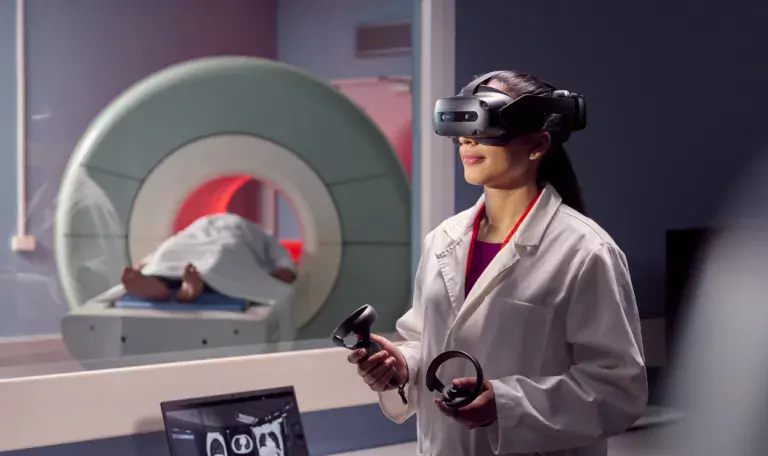The traditional models of care and service delivery for providers of aging services are shifting toward a new normal. With the industry having faced tough challenges in recent years, providers have seen those challenges as opportunities for transformation and innovation.
One such challenge has been finding safe solutions to help residents engage with family members, participate in daily activities, and interact with their care team members. Given that prolonged isolation can result in negative health outcomes, maintaining these key interactions remains critical to residents’ health and well-being.
Increased Risk Resulting from Social Isolation
According to the American Heart Association, loneliness and social isolation are independent risk factors for cardiovascular and brain health problems. People who are socially isolated or feel lonely are about 30% more likely to experience or die from heart attacks and strokes. Social isolation can also increase the risk of dementia by 50%.
The aging population is particularly vulnerable. According to recent studies, one-quarter of adults 65 and older are socially isolated and about half of them are lonely. i
An Industry Call to Action: Embrace Innovation
Keeping residents and staff safe proves to be a herculean task for providers even today. Providers are re-designing processes to minimize levels of risk or to manage staffing shortages. At the same time, care facilities are facing challenges in maintaining the amount of quality, in-person time they spend with residents. In many cases, social activities are not at the levels residents have enjoyed in the past. Although visits with loved ones are rebounding, there may still be restrictions in place.
Many organizations employ creative solutions to maintain engagement including scalable ones that build connections through virtual interaction. Through technology, residents can enjoy more opportunities to safely connect with family and friends across town or the globe.
Until very recently, senior living communities have been at a disadvantage when it comes to technology, relying mostly on archaic and outdated solutions. The last two years have energized and encouraged senior care providers to make significant investments in technology – a move that has paid off with permanent communication and entertainment systems inside many communities.ii In fact, after 2020, nearly 80% of senior living providers increased their investments in smart technology. iii
Building Connections Through a Single Solution
There’s little doubt that the care continuum’s movement towards virtual care and engagement has indeed accelerated. Connected care that leverages tools like video conference calling and in-room tablets is now a reality of how we all stay connected. These tools prove especially helpful in connecting aging residents with loved ones inside and outside of their facilities and communities. These are useful tools and continue to evolve to account for scalability and device accessibility.
Industry experts acknowledge that hybrid care and digital connections are the new reality for the healthcare industry. [i] Therefore, the time is right to choose solutions like the ThinkPad T14 Gen 3 or the ThinkPad X1 Yoga Gen 3 powered by Intel vPro®, An Intel® Evo™ Design with 12th Gen Intel® Core™ i7 processors -– technology that can meet the challenges of limited in-person interactions. These can be deployed facility-wide or community-wide and are compliant with relevant regulatory requirements.
But how will residents, staff, and family members benefit?
Residents
Staying connected helps assisted care residents maintain mental and emotional health and well-being. With in-room or in-unit devices, residents are empowered to connect and communicate digitally with friends and family members across town or even across the globe. When internal restrictions are in place, residents can also safely engage with those within the community or facility.
Staff
Staff can enjoy the flexibility to re-think how they conduct many important social therapeutic activities to adhere to the latest safety protocols. With all residents having access to a virtual engagement solution, programs like art, music therapy, or even a bingo game can be conducted safely and include more residents.
Family
For family members, peace of mind can come with knowing they can reach their loved ones at any time of day via a video call. Digital solutions can also strengthen trust and confidence between family members and their loved one’s care team. When both parties can easily engage and communicate with each other, deeper insights into how residents are functioning day-to-day can be gained.
These are but a few of the ways a virtual care and engagement solution will elevate the day-to-day experiences of your residents, staff, and family members. The possibilities are wide open for those who embrace technology and see this experience as a fundamental shift in how we care for our aging population.
Together with our partners, Lenovo delivers modern IT solutions for a smarter way forward. Let us know how we can help.
Lenovo Health’s “Trends to Track” series highlights news and industry reports impacting healthcare decision-makers, with a fresh look at current topics and trends. Be sure to check back for new stories. And make it social by clicking on the social media icons at the top of the page!
Smarter delivers the best experience and insights for employees – onsite or remote – to drive healthcare forward. Learn more at lenovo.com/health






